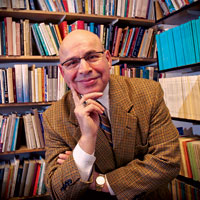 |
|
Spring 2007 | Volume 30, Number 1
| Features
|
|
|
"Multifaceted" continued

Frank Spina: "We read the Bible as Scripture to encounter God." |
The Bible as Scripture
By Frank Anthony Spina, Professor of Old Testament
It must sound curious to advocate reading the Bible as Scripture. How else would Christians read the Bible? After all, the Bible
is Scripture and therefore must surely be read as such. Why
belabor the obvious? Actually, that is not a rhetorical question because, in point of fact, the Bible is typically read as something besides Scripture.
At the very least, the Bible is often read with a less-than- robust theological conception of Scripture. Examples abound. The Bible is occasionally read to garner historical information for periods of biblical history in which one happens to be interested. Or the Bible is read for inspirational stories or examples of exemplary faith. Sometimes the Bible is read for the purpose of culling out various truth claims about God or other religious and ethical matters. Equally, the Bible is approached as a handbook or guide, a sort of religious encyclopedia to be consulted depending on the “topic” with which one is concerned.
Granted, there is some validity to each of these ways of
reading. But none of them are grounded in a sufficiently sub-stantive theological understanding of Scripture. First and foremost, Scripture as a theological concept means the Bible is the church’s book, not in terms of mundane ownership, but in terms of providing the context for biblical expression, interpretation, and appropriation. The church as the body of Christ is the proper setting for reading the Bible as Scripture. Within the church, the Bible is read as Scripture in the context of worship, prayer, discipleship, catechism, service, and mission. An ecclesial or “churchly” reading is in essence a communal reading, even when we read ostensibly as individuals. The church provides
all its “saints” — those who make up the body of Christ —
with the “rule of faith” that guides the collective reading of
the Bible as Scripture.
Emphasizing this “churchly” reading is based on the belief that the Bible is the decisive and indispensable witness to divine revelation. Christianity has always believed that apart from divine self-disclosure, God cannot be adequately known or apprehended. Accordingly, the main thrust of the Bible as Scripture is recounting the story of God’s revelation through Israel, the elect people of God through whom God will bless “all the families of the earth” (Genesis 12:3), and the story of Jesus the Christ, Israel’s messiah, through whom, as the risen and exalted Lord, God will bring about the redemption and reconciliation of the whole created order. That’s why this biblical story “in two acts” (Old Testament and New Testament) must be part of the warp and woof of the church — its worship structure, its hymnology, its preaching, its teaching ministry, its catechism, its evangelism, its good works, its calendar, even its art forms.
When we read the Bible as Scripture in the context of the church, under the tutelage of the Holy Spirit, we do not primarily seek information, but rather seek to encounter God, the very One who is witnessed to in its pages. God in and through Israel and in and through Christ the Lord is the protagonist, so to speak, of Holy Scripture. Reading the Bible as Scripture is not designed to elicit the response, “That’s interesting,” but “I believe.”
This is clear from Scripture’s rhetorical make-up. The Bible has been written, edited, and arranged to persuade its readers and hearers of the truth of what God has done to save the
whole created order (John 20:30–31). Again, this truth is not
a matter merely of increasing our knowledge; rather, it is a
matter of transformation. Encountering God through Scripture in the context of the church, the body of Christ, at the direction of the Holy Spirit, is designed to orient us to our place in the kingdom of God and to make us keenly aware of our vocation
in that kingdom.
Reading the Bible as Scripture is finally a means of
grace whereby the church keeps its “story” straight, acquires
a “grammar of faith,” is made aware of the cadences of its religious expression, embraces the necessity and the delight of
being saturated with biblical lore, and becomes fluent in a
common, corporate language understood by all who are part
of the body of Christ, the “one holy, catholic, and apostolic church” (the Nicene Creed).
Back to Story | Back | Next Page 3 of 5
Back to the top
Back to Features Home
|
| |
|
 |
 |

|
 |
from the president
Embracing the Christian Story
SPU President Philip Eaton asks what would happen if the Bible were at the center of the learning enterprise.
campus
Destination: Asia
SPU President Philip Eaton joined a historic delegation of U.S. university presidents that visited Asia.
alumni
Coffee as Change Agent?
Pura Vida employees, including several SPU alumni, engage the culture using a social-venture business model.
books, film, & music
Dark Alphabet
Jennifer Maier, poet and SPU associate professor of English, receives a literary award for her first book.
athletics
National Tournament Returns
For the first time in 10 years, SPU hosts the USA Gymnastics Women's Collegiate Championship.
my response
Undone by the Word
Response writer Kathy Henning shares her journey to know the Bible better.
Response art
Pink Emperors
Class of 1973 alumna Jill Ingram introduces Response readers to “Pink Emperors.”
|
 |
|
 |